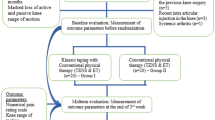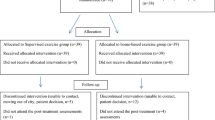Abstract
The aim of this study was to evaluate effects of electrical stimulation combined with continuous passive motion (CPM–ES) versus isometric exercise on symptoms, functional capacity, quality of life, muscle strength, knee and thigh circle measurements, and balance in knee osteoarthritis (OA). This is a randomized clinical trial. The study was done in Gulhane Military Medical Academy (GMMA) Rehabilitation Center. Forty patients with knee OA were included in this study. Participants were randomly assigned to two groups: 20 patients placed in Group 1 were treated with conventional physical therapy and CPM–ES combination; 20 patients in Group 2 were treated with conventional physical therapy and isometric exercise. Therapies were applied 3 weeks, 5 days per week. The following main outcome measures were done: values of pain (VAS was used), WOMAC, SF-36, knee and thigh circle measurements, isokinetic tests, dynamic and static balance tests were determined at baseline and after the treatment. There were no statistically significant differences in the tested variables between the groups for post-treatment values. Dynamic and static balance test improved statistically strongly significantly in both groups. The findings of this study demonstrate that knee OA patients could improve their balance function in both static and dynamic conditions after CPM–ES combination or isometric exercise therapy. The improvement might prevent knee OA patients from falling down and increase their sense of security during physical activities.
Similar content being viewed by others
References
Peat G, McCarney R, Croft P (2001) Knee pain and osteoarthritis in older adults: a review of community burden and current use of health care. Ann Rheum Dis 60:91–97
Murray CJL, Lopez AD (1997) The global burden of disease. World Health Organisation, Geneva
Maurer BT, Stern AG, Kinossian B, Cook KD, Schumacher HR Jr (1999) Osteoarthritis of the knee: isokinetic quadriceps exercise versus an educational intervention. Arch Phys Med Rehabil 80(10):1293–1299
O’Reilly SC, Jones A, Muir KR, Doherty M (1998) Quadriceps weakness in knee osteoarthritis: the effect on pain and disability. Ann Rheum Dis 57(10):588–594
Slemenda C, Brandt KD, Heilman DK, Mazzuca S, Braunstein EM, Katz BP, Wolinsky FD (1997) Quadriceps weakness and osteoarthritis of the knee. Ann Intern Med 127(2):97–104
Ytterberg SR, Mahowald ML, Krug HE (1994) Exercise for arthritis. Baillieres Clin Rheumatol 8(1):161–189
Hinman RS, Bennell KL, Metcalf BR et al (2002) Balance impairments in individuals with symptomatic knee osteoarthritis: a comparison with matched controls using clinical tests. Rheumatology 41:1388–1394
Campbell AJ, Borrie MJ, Spears GF (1989) Risk factors for falls in a community-based prospective study of people 70 years and older. J Gerontol 44:112–117
Kirkley A, Webster-Bogaert S, Litchfield R et al (1999) The effect of bracing on varus gonarthrosis. J Bone Jt Surg Am 81:539–548
Sharma L, Pai YC (1997) Impaired proprioception and osteoarthritis. Curr Opin Rheumatol 9:253–258
Barrett DS, Cobb AG, Bentley G (1991) Joint proprioception in normal, osteoarthritic and replaced knees. J Bone Jt Surg Br 73:53–56
Laghman RK, Youdas JW (1983) Strength changes in the normal quadriceps femoris muscle as a result of electrical stimulation. Phys Ther 63(4):494–499
Currier DP, Mann R (1983) Muscular strength development by electrical stimulation in healthy individuals. Phys Ther 63:915–921
Selkowitz DM (1985) Improvement in isometric strength of the quadriceps femoris muscle after training with electrical stimulation. Phys Ther 65:186–196
Soo CL, Currier DP, Therkeld AJ (1988) Augmenting voluntary torque of healthy muscle by optimization of electrical stimulation. Phys Ther 68:333–337
Bellamy N, Buchanan WW, Goldsmith CH, Campbell J, Stitt LW (1988) Validation study of WOMAC: a heath status instrument for measuring clinically important patient relevant outcomes to antirheumatic drug therapy in patients with osteoarthritis of the hip and knee. J Rheumatol 15:1833–1840
McHorney CA, Ware JE Jr, Lu JF, Sherbourne CD (1994) The MOS 36-item short-form health Survey (SF-36): III. Tests of data quality, scaling assumptions, and reliability across diverse patient groups. Med Care 32(1):40–66
Losse GM, Howard ME, Cawley PW (1994) Correlation of lower extremity injury to balance indices: an investigation utilizing an instrumented unstable platform. In: The American Orthopaedic Society for Sports Medicine’s Specialty Day, American Academy of Orthopaedic Surgeons Annual Meeting, New Orleans, LA, 27 February 1994
Gehlsen GM, Whaley MH (1990) Falls in the elderly: Part II, balance, strength, and flexibility. Arch Phys Med Rehabil 71:739–741
Gehlsen GM, Whaley MH (1990) Falls in the elderly: Part I, gait. Arch Phys Med Rehabil 71(10):735–738
Wigren A, Nordesjö LO, Nordgren B, Kolstad K (1983) Isometric muscle strength and endurance after knee arthroplasty with the modular knee in patients with osteoarthrosis and rheumatoid arthritis. Scand J Rheumatol 12(2):145–151
Lankhorst GJ, Van de Stadt RJ, Van der Korst JK (1985) The relationships of functional capacity, pain, and isometric and isokinetic torque in osteoarthrosis of the knee. Scand J Rehabil Med 17(4):167–172
Jones G, Nguyen T, Sambrook PN, Lord SR, Kelly PJ, Eisman JA (1995) Osteoarthritis, bone density, postural stability, and osteoporotic fractures: a population based study. J Rheumatol 22(5):921–925
Durmuş D, Alayli G, Cantürk F (2007) Effects of quadriceps electrical stimulation program on clinical parameters in the patients with knee osteoarthritis. Clin Rheumatol 26(5):674–678
Kaplan FS, Nixon JE, Reitz M et al (1985) Age-related changes in proprioception and sensation of joint position. Acta Orthop Scand 56:72–74
Whipple R, Wolfson L, Derby C et al (1993) Altered sensory function and balance in older persons. J Gerontol 48:71–76
Messier SP, Glasser JL, Ettinger WH et al (2002) Declines in strength and balance in older adults with chronic knee pain: a 30-month longitudinal, observational study. Arthritis Rheum 47:141–148
Lord SR, Clark RD, Webster IW (1991) Physiological factors associated with falls in an elderly population. J Am Geriatr Soc 39:1194–2000
Author information
Authors and Affiliations
Corresponding author
Rights and permissions
About this article
Cite this article
Tok, F., Aydemir, K., Peker, F. et al. The effects of electrical stimulation combined with continuous passive motion versus isometric exercise on symptoms, functional capacity, quality of life and balance in knee osteoarthritis: randomized clinical trial. Rheumatol Int 31, 177–181 (2011). https://doi.org/10.1007/s00296-009-1263-2
Received:
Accepted:
Published:
Issue Date:
DOI: https://doi.org/10.1007/s00296-009-1263-2




